 "ttyymmnn" (ttyymmnn)
"ttyymmnn" (ttyymmnn)
07/31/2018 at 12:35 • Filed to: wingspan, Planelopnik, TDIAH
 9
9
 21
21
 "ttyymmnn" (ttyymmnn)
"ttyymmnn" (ttyymmnn)
07/31/2018 at 12:35 • Filed to: wingspan, Planelopnik, TDIAH |  9 9
|  21 21 |
!!! UNKNOWN CONTENT TYPE !!!
Welcome to
This Date in Aviation History
, getting of you caught up on milestones, important historical events and people in aviation from July 28 through July 31.
!!! UNKNOWN CONTENT TYPE !!!
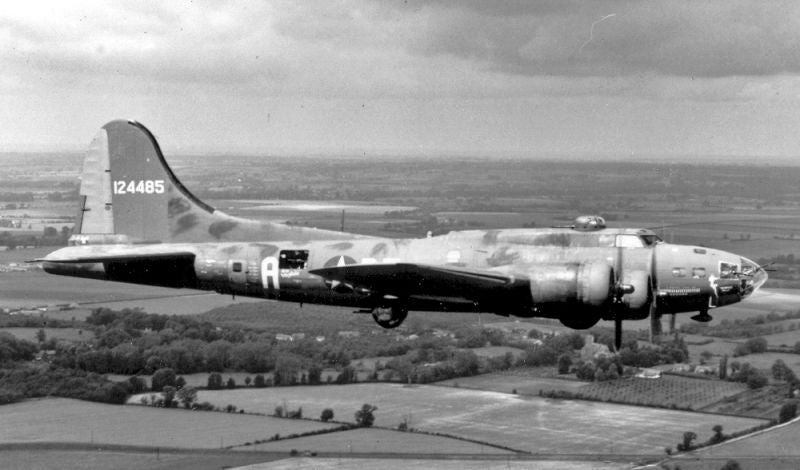 !!!CAPTION ERROR: MAY BE MULTI-LINE OR CONTAIN LINK!!!
!!!CAPTION ERROR: MAY BE MULTI-LINE OR CONTAIN LINK!!!
July 28, 1935 – The first flight of the Boeing B-17 Flying Fortress. In the lead up to the Second World War, two schools of thought emerged on how bombers could be used in battle: tactical and strategic. Tactical bombing was conceived as a way to support ground forces in the achievement of a specific objective, such as overcoming a fortified position or destroying a bridge, while strategic bombing was carried out by waves of bombers flying over enemy territory in an effort to destroy factories and deprive the armies of war materiel or flatten cities in hopes of destroying the morale of the civilian population. The Germans focused on the former, and honed the combined arms tactics into the Blitzkrieg warfare that was so effective early in the war. England and America, however, adopted the strategic theories of bombing, particularly those of Italian !!!error: Indecipherable SUB-paragraph formatting!!! . Proponents such as !!!error: Indecipherable SUB-paragraph formatting!!! in England and !!!error: Indecipherable SUB-paragraph formatting!!! in America advocated the construction of fleets of heavy bombers based on the belief that “ !!!error: Indecipherable SUB-paragraph formatting!!! .”
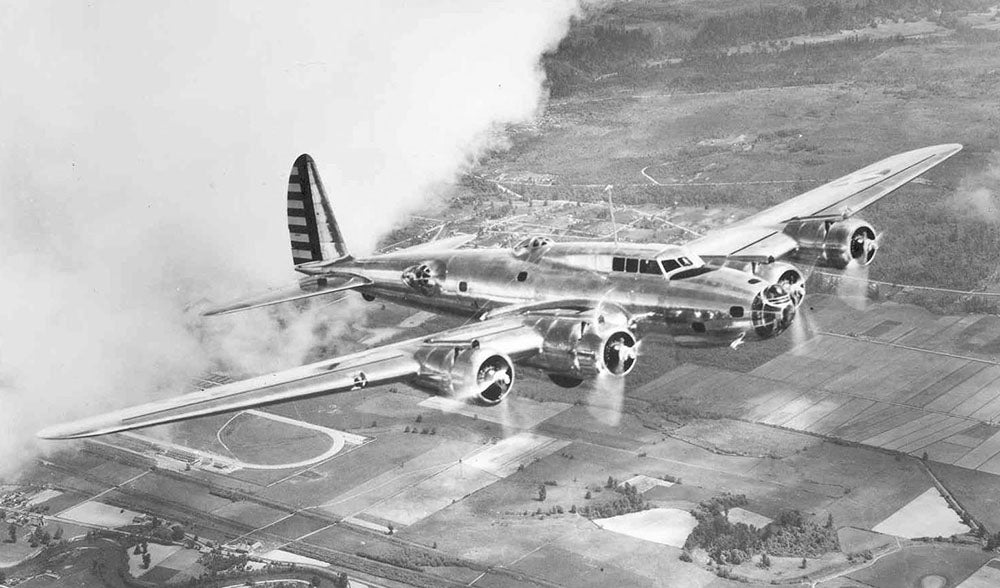
YB-17 prototype (US Air Force)
During the 1930s, rapid advances in aircraft design and construction left behind the fabric-covered biplanes of the 1920s in favor of all-metal monoplanes of increasing size, strength and capability. Boeing introduced the US Army Air Corps’ first all-metal bomber with the !!!error: Indecipherable SUB-paragraph formatting!!! in 1931, and Martin followed with the first truly modern bomber in 1934, the !!!error: Indecipherable SUB-paragraph formatting!!! . But as soon as the B-10 entered service, the USAAC began the search for a new bomber to replace it, one that would be capable of carrying a “useful bomb load” at 10,000 feet, could stay aloft for 10 hours, and would have a speed of 200 mph. A competition took place at Wright Field in Ohio between the !!!error: Indecipherable SUB-paragraph formatting!!! , the !!!error: Indecipherable SUB-paragraph formatting!!! , both twin-engine aircraft, and the Boeing Model 299, which had four engines. When the new Boeing bomber, bristling with defensive armament, was first rolled out to the press, a newspaper reporter remarked that the bomber looked like a “flying fortress,” and the name stuck.
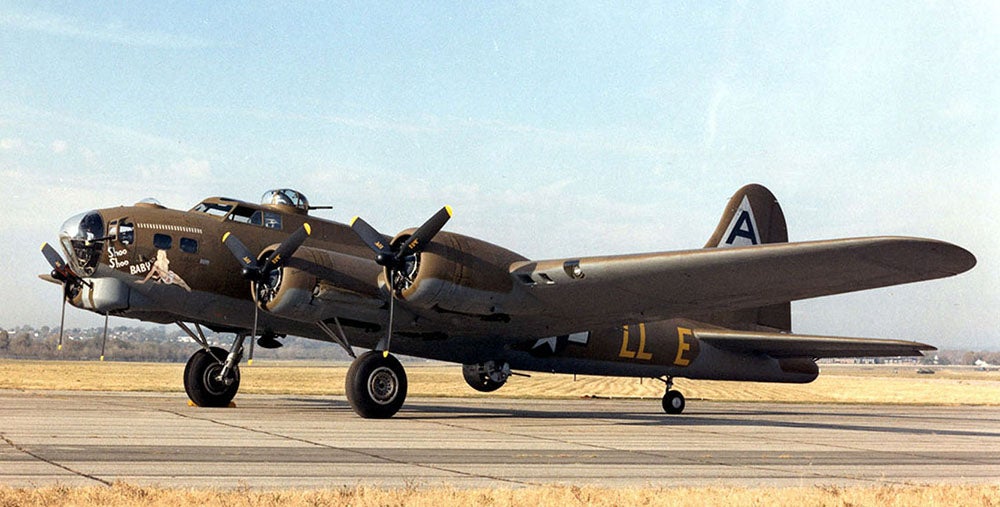
B-17G Shoo Shoo Baby. The G model was the definitive Flying Fortress, with 8,680 built. The addition of a chin turret gave the B-17G a total of 11 defensive machine guns. (US Air Force)
While USAAC brass were impressed by the performance of the Model 299, now carrying the designation YB-17, they were concerned about the higher cost of the larger bomber and, when a crash during testing destroyed the Boeing prototype, the Air Corps chose the Martin bomber. But this was not the end of the B-17. Its performance was impressive enough for the USAAC to order 13 YB-17s for further evaluation, and its performance in testing was so good that by the outbreak of WWII in December of 1941 there were already 155 Flying Fortresses in the air. And, as the Flying Fortress showed its mettle in combat, those numbers soon soared into the thousands. Though the B-17 dropped its first bombs in combat in the hands of RAF pilots, it was the US Army Air Forces that flew thousands of missions over occupied Europe. The B-17G variant, which was built in the greatest numbers (over 8,000), had no less than 13 defensive !!!error: Indecipherable SUB-paragraph formatting!!! .50 caliber machine guns and could carry up to 8,000 pounds of bombs depending on the mission. Wartime production of the B-17 was carried out by Boeing, Douglas and Vega, a subsidiary of Lockheed, and eventually a staggering total of 12,731 Flying Fortresses were produced by the end of the war.
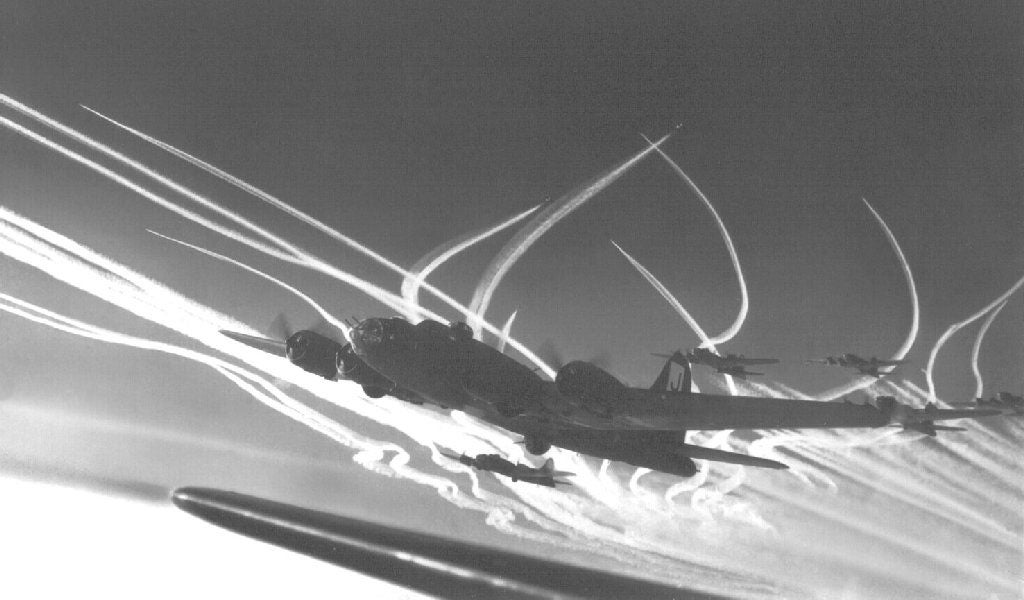
Boeing B-17F Flying Fortresses of the 390th Bomb Group and their P-47 Thunderbolt escorts leave vapor trails at high altitude over Europe in December 1943. (US Air Force)
And while the bomber didn’t always get through, the Flying Fortress was capable of withstanding an enormous amount of damage while still bringing its crew home. The B-17 became the iconic American bomber of the war in Europe, teaming up with the !!!error: Indecipherable SUB-paragraph formatting!!! and other smaller bombers to rain 1.4 million tons of bombs on German targets, with the B-17 accounting for roughly half that number. As for strategic bombing, !!!error: Indecipherable SUB-paragraph formatting!!! found mixed results. While Germany’s production of oil and ammunition was significantly affected, along with the almost total destruction of transportation capabilities and the halt of submarine production, supplies of aircraft actually increased throughout the war, and other supplies, such as ball bearings and steel, were virtually unaffected. Anywhere from 350,000 to 500,000 German civilians were !!!error: Indecipherable SUB-paragraph formatting!!! , but bombing itself did not lead directly to German capitulation. Following the war, the vast majority of B-17s were broken up and sold for scrap, though a handful continued to serve in different roles. The Brazilian Air Force retired its last Flying Fortress in 1968, and today only about 14 remain airworthy, none of which are combat veterans.
!!! UNKNOWN CONTENT TYPE !!!
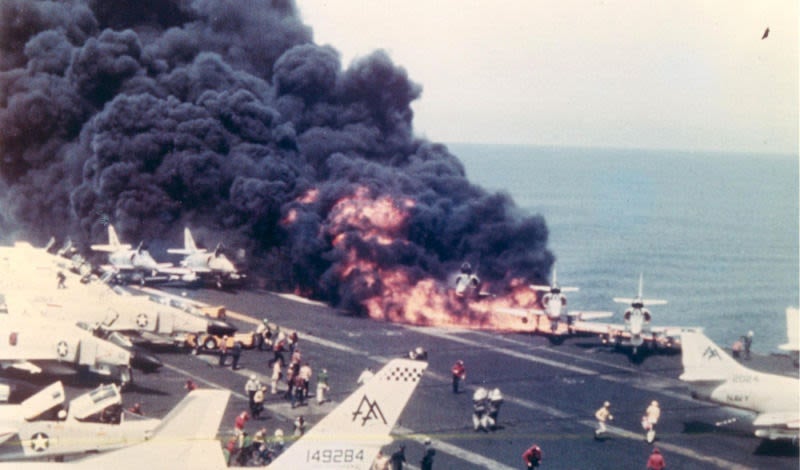
July 29, 1967 – Fire engulfs the flight deck of USS Forrestal off the coast of Vietnam. Working on the flight deck of an aircraft carrier has been called one of the most dangerous jobs in the world. Controlling jet and propeller aircraft around a pitching deck is an intricate ballet of blasting jet engines and spinning propellers, with death or serious injury a constant concern. And that is just during peacetime. In war, the dangers are compounded by a higher tempo of operations and the presence of bombs, missiles, rockets and fully-fueled aircraft either on the flight deck or stored belowdecks. In fact, the !!!error: Indecipherable SUB-paragraph formatting!!! took a critical turn when American dive bombers arrived overhead while Japanese aircraft were sitting on deck, fully loaded with bombs and fuel. The US Navy has been honing the art of carrier operations and carrier safety since 1920, but despite rigid safety procedures, there is always the potential for disaster.
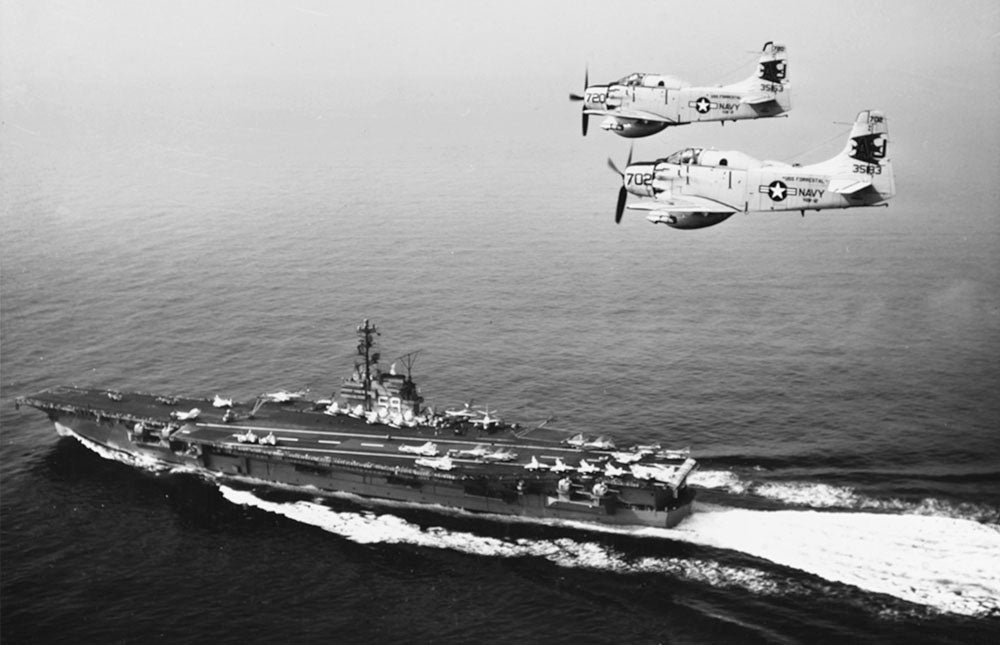 !!!CAPTION ERROR: MAY BE MULTI-LINE OR CONTAIN LINK!!!
!!!CAPTION ERROR: MAY BE MULTI-LINE OR CONTAIN LINK!!!
By the early summer of 1967, the war in Vietnam was escalating dramatically, and the carrier !!!error: Indecipherable SUB-paragraph formatting!!! (CVA-59) sailed from Norfolk, Virginia to take up a position at !!!error: Indecipherable SUB-paragraph formatting!!! in the !!!error: Indecipherable SUB-paragraph formatting!!! off the coast of Vietnam. Once there, Forrestal immediately began launching attacks against North Vietnam in support of American and South Vietnamese troops. With the pace of operations increasing, the Navy’s demand for bombs soon outstripped production. To keep the bombers flying, the Navy was forced to use older ordnance, some of which dated back more than 10 years and had been exposed to the elements while in storage. On the day preceding the accident, Forrestal received a shipment of 1000-pound bombs, many of which were older, unstable bombs that had been improperly stored in Guam. Forrestal’s commanding officer, Captain !!!error: Indecipherable SUB-paragraph formatting!!! , wanted to refuse the munitions, but he ended up accepting them reluctantly because of the acute shortage of munitions and the need for the bombs on missions the following day. Forrestal’s bomb handlers were particularly concerned with the unstable bombs being stored belowdecks, where an accidental explosion could sink the entire ship. So the bombs were stored out in the open on the flight deck.
The next day, the deck of Forrestal was crammed with fueled and armed aircraft and swarming with deck handlers and other personnel. Shortly before 11:00 am an electrical anomaly in a 5-inch !!!error: Indecipherable SUB-paragraph formatting!!! caused it to launch unintentionally from a !!!error: Indecipherable SUB-paragraph formatting!!! parked on the flight deck. The missile struck the external fuel tank on an armed !!!error: Indecipherable SUB-paragraph formatting!!! and, while the rocket did not explode, it punctured the fuel tank, and the leaking fuel ignited. As damage control teams rushed to fight the rapidly spreading fire, one of the unstable bombs loaded on the Skyhawk detonated, blowing a hole in the armored flight deck. The explosion also raked the damage control team with shrapnel and covering the deck in even more burning fuel. As the fires continued to rage, nine more explosions occurred, eight of which were caused by the unstable bombs. The detonations tore holes in the flight deck that allowed burning jet fuel to flow into the living quarters below and into the interior spaces of the ship. Without heavy equipment, Forrestal’s crew pushed damaged aircraft into the water and rolled bombs over the side of the ship by hand. With the aid of the destroyer !!!error: Indecipherable SUB-paragraph formatting!!! !!!error: Indecipherable SUB-paragraph formatting!!! (DD-851), which came within 20 feet of Forrestal to use its own fire hoses, Forrestal’s crew was eventually able to extinguish the fire by 4:00 am the following morning. The fire and explosions claimed the life of 134 crewmen, and 161 were injured, many of them seriously. Forrestal returned to Norfolk, where itspent more than 200 days undergoing repairs and refitting before returning to service. Though Capt. Beling was absolved of responsibility for the fire, he was assigned to staff work following the incident and retired in 1973 with the rank of Rear Admiral. Forrestal was decommissioned in 1993.
!!! UNKNOWN CONTENT TYPE !!!
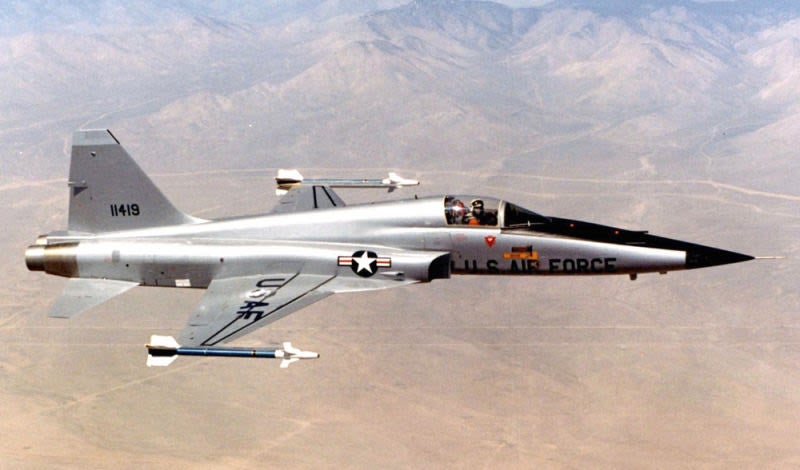
Northrop F-5E Freedom Fighter (US Air Force)
July 30, 1959 – The first flight of the Northrop F-5A Freedom Fighter. When the first jet fighters took flight at the end of WWII, they were relatively simple affairs, essentially straight-winged piston aircraft that were adapted for the new turbojet engines. But as jet engines became more powerful, fighters got bigger, more complex—and more expensive. To combat this trend, Northrop began working on a small, simple fighter in the mid-1950s called the N-156 in the hopes of securing a contract to produce a fighter that could fly from the US Navy’s smaller !!!error: Indecipherable SUB-paragraph formatting!!! . The design team was led by Northrop’s vice president of engineering !!!error: Indecipherable SUB-paragraph formatting!!! , who designed two of arguably the greatest fighters ever built, the !!!error: Indecipherable SUB-paragraph formatting!!! and !!!error: Indecipherable SUB-paragraph formatting!!! , before coming to Northrop. Along with chief engineer Welko Gasich, the Northrop team set out with the specific goal of creating a small, low-cost fighter that would be easy to maintain and easy to fly, but would also have the potential for future growth and development.
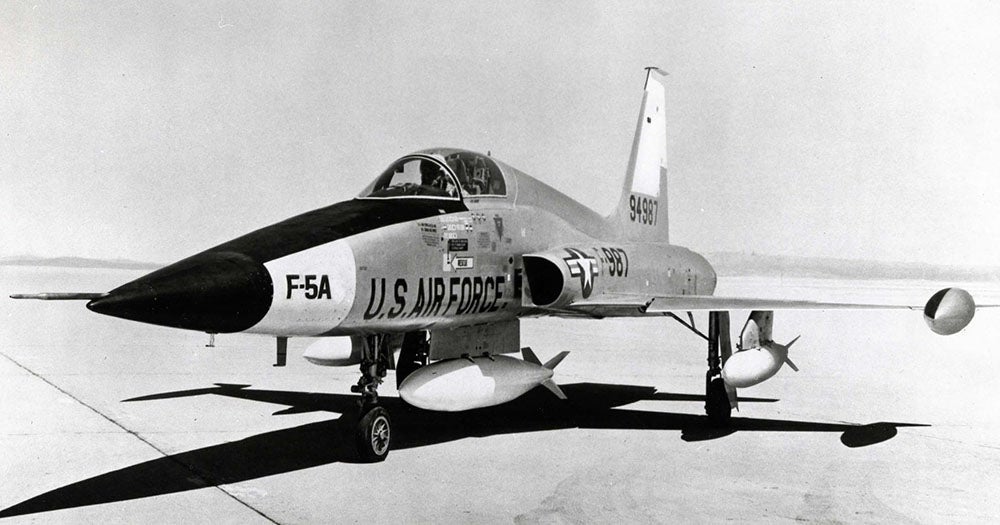
Northrop YF-5A prototype. (US Air Force)
Not only were fighters getting larger and larger, but the engines that powered them were also growing in size and complexity. To keep the size of their new fighter at a minimum, Northrop selected two powerful !!!error: Indecipherable SUB-paragraph formatting!!! turbojet engines which had been designed originally to power the !!!error: Indecipherable SUB-paragraph formatting!!! target decoy. Though the J85 was small, weighing in at just 300-500 pounds each, it provided 3,500 pounds of thrust in normal operation and 5,000 pounds with afterburner. Combined with the fighter’s small size and use of the !!!error: Indecipherable SUB-paragraph formatting!!! , which gave the F-5 its characteristic slim waist, the F-5 was capable of a top speed of Mach 1.6 with a thrust-to-weight ratio of up to 7.5:1 compared to the !!!error: Indecipherable SUB-paragraph formatting!!! at just 4.7:1. The F-5 was armed with two 20mm !!!error: Indecipherable SUB-paragraph formatting!!! revolver cannons in the nose with 280 rounds each. Seven hardpoints could carry up to 7,000 pounds of bombs, rockets, missiles, or extra fuel tanks.
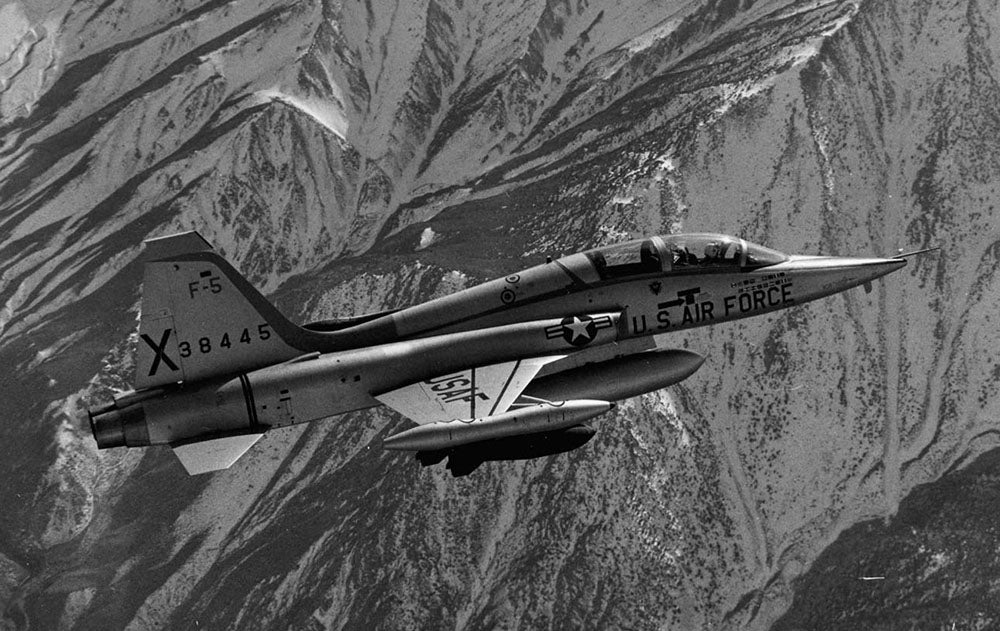
The two-seat F-5B, which was later developed into the remarkably successful T-38 Talon trainer. (US Air Force)
The changing needs of the US Navy led them to abandon the use of smaller escort carriers, but Northrop forged ahead with their design and developed both a single-seat fighter version, the N-156F, and a two-seat trainer version, the N-156T. In July 1956, the Air Force chose the N-156T to replace the !!!error: Indecipherable SUB-paragraph formatting!!! as its primary trainer, and the newly designated !!!error: Indecipherable SUB-paragraph formatting!!! became both the first supersonic trainer and eventually the most-produced trainer in the world. Northrop continued developing the N-156F in the hopes of providing a fighter for the !!!error: Indecipherable SUB-paragraph formatting!!! , which sought to arm nations allied to the US with low-cost weapons, and it was this aircraft which took its first flight on July 30, breaking the sound barrier on its maiden flight.
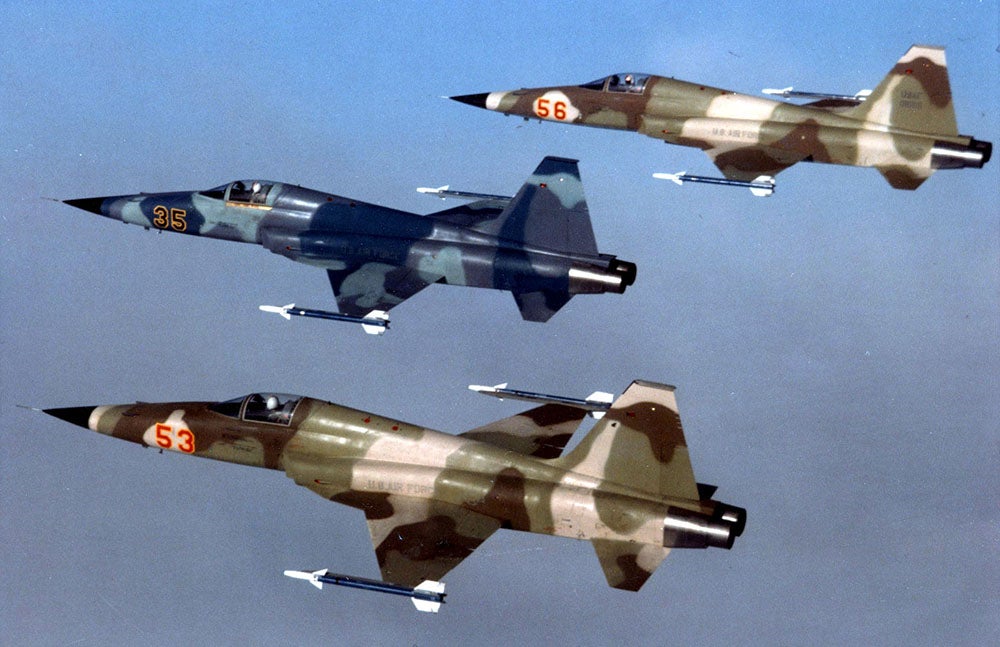
A trio of three US Air Force aggressor Northrop F-5E aircraft over England in 1983. These aircraft are painted to resemble Soviet fighters. (US Air Force)
Despite the excellent performance and reliability of the F-5, the Air Force showed little interest in the fighter, and the program was in danger of being shut down. However, the Kennedy Administration chose the F-5 in 1962 as the winner of the F-X completion to provide a low-cost export fighter the America’s allies. In 1965, the Air Force sent 12 F-5As to Vietnam to evaluate them under the codename Project Skoshi Tiger, and it was here that the F-5 received its unofficial nickname, which became official with the later F-5E/F Tiger II. While the F-5A and F-5E/F weren’t adopted in large numbers by the US, it continues to be flown in the aggressor role for dissimilar combat training, and the Air Force has also bought back some export fighters for use in this role. The Tiger II, which won the International Fighter Aircraft competition in 1970, remains in service alongside older Freedom Fighters the world over. Northrop attempted yet another upgrade to the venerable little fighter with the !!!error: Indecipherable SUB-paragraph formatting!!! , hoping to develop an export fighter to compete with the !!!error: Indecipherable SUB-paragraph formatting!!! , but it was ultimately unsuccessful. By the end of production in 1987, a total of 847 F-5A/B/C aircraft had been built, along with nearly 1,400 F-5E/Fs.
!!! UNKNOWN CONTENT TYPE !!!
Short Takeoff
!!! UNKNOWN CONTENT TYPE !!!
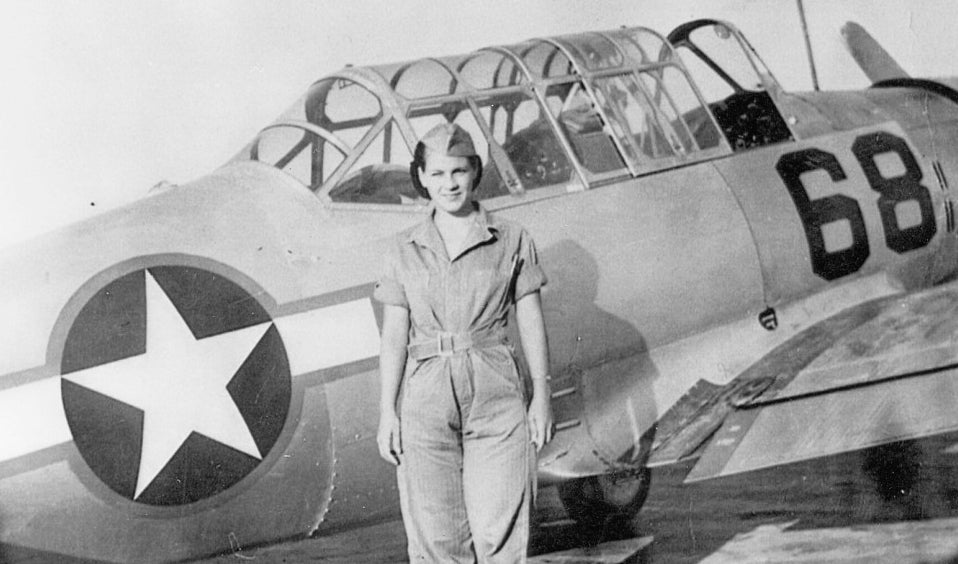
July 28, 2008 – The death of Margaret Ringenberg.
Born in Fort Wayne, Indiana on June 17, 1921, Ringenberg learned to fly in 1941 at age 19 and began her flying career in 1943 as part of the
!!!error: Indecipherable SUB-paragraph formatting!!!
(WASP), ferrying aircraft, performing test flights, and pulling targets for fighter practice. After the war, Ringenberg took up air racing, eventually earning over 150 trophies, and competed in the Round-the-World Air Race in 1994 at the age of 72. At the time of her death, Ringenberg had amassed more than 40,000 hours of flying time.
!!! UNKNOWN CONTENT TYPE !!!
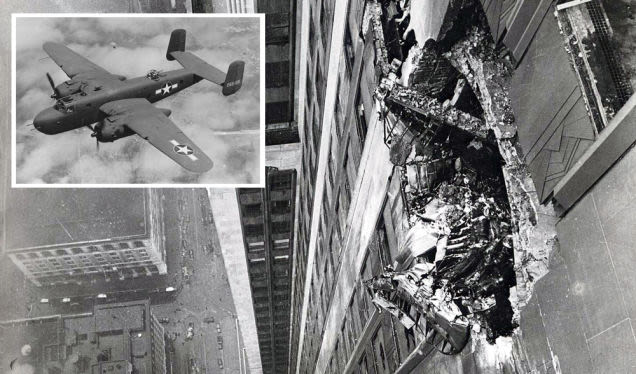
(Ernie Sisto; US Air Force)
July 28, 1945 – A North American B-25 Mitchell crashes into the Empire State Building.
During a period of thick fog over New York City, a US Army Air Forces
!!!error: Indecipherable SUB-paragraph formatting!!!
was performing a routine personnel transport mission when the pilot was instructed to abort his landing and proceed to Newark Airport due to poor visibility. Becoming disoriented in the fog, pilot William Smith crashed into the
!!!error: Indecipherable SUB-paragraph formatting!!!
between the 78th and 80th floors, killing himself, his two passengers, and 11 civilians in the skyscraper. Based on this accident, the architects of the
!!!error: Indecipherable SUB-paragraph formatting!!!
considered the possibility of an accidental crash of a
!!!error: Indecipherable SUB-paragraph formatting!!!
when they designed the towers, little knowing that such a scenario would play out purposefully in 2001.
!!! UNKNOWN CONTENT TYPE !!!
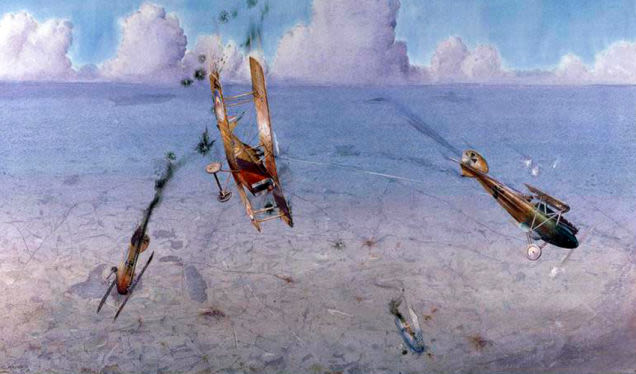
(UK Government(
July 28, 1914 – World War I begins. World War I was a watershed event in the history of aviation, as the airplane became a weapon of war a mere 11 years after the First Flight of the !!!error: Indecipherable SUB-paragraph formatting!!! . First entering the fray as observation planes known as scouts, pilots soon began shooting at each other with small arms, and the first dedicated combat aircraft, the !!!error: Indecipherable SUB-paragraph formatting!!! , arrived in early 1915. Technological advances brought ever more powerful and faster fighters, including an interrupter mechanism created by !!!error: Indecipherable SUB-paragraph formatting!!! to allow fighters to fire through the arc of the propeller. By the end of the war, the Germans has lost more than 27,000 aircraft to enemy fire or crashes, while members of the !!!error: Indecipherable SUB-paragraph formatting!!! powers lost more than 88,000. More than 15,000 airmen were lost.
!!! UNKNOWN CONTENT TYPE !!!

July 29, 1958 – President Dwight Eisenhower signs the National Aeronautics and Space Act, creating NASA. NASA has its origin in the !!!error: Indecipherable SUB-paragraph formatting!!! , an agency created in 1915 to further the efforts of aeronautic research and technological development in the United States. But as America entered the space age following WWII, the country needed an organization for a new era. The !!!error: Indecipherable SUB-paragraph formatting!!! carries this simple preamble: To provide for research into problems of flight within and outside the earth’s atmosphere, and for other purposes. While NASA has done, and continues to do, research that carries military implications, its stated purpose is that of a peaceful, non-military organization. The Act goes on to say that, “The Congress hereby declares that it is the policy of the United States that activities in space should be devoted to peaceful purposes for the benefit of all mankind.” In addition to NASA’s high profile space programs such as !!!error: Indecipherable SUB-paragraph formatting!!! , !!!error: Indecipherable SUB-paragraph formatting!!! , !!!error: Indecipherable SUB-paragraph formatting!!! , the !!!error: Indecipherable SUB-paragraph formatting!!! , and the !!!error: Indecipherable SUB-paragraph formatting!!! , the organization continues to fund research into all aspects of space exploration, space travel, aviation, and related sciences. NASA’s latest large project, the !!!error: Indecipherable SUB-paragraph formatting!!! and the !!!error: Indecipherable SUB-paragraph formatting!!! Multi-Purpose Crew Vehicle, will see astronauts return to the Moon, create a permanent lunar station, and one day journey to Mars.
!!! UNKNOWN CONTENT TYPE !!!
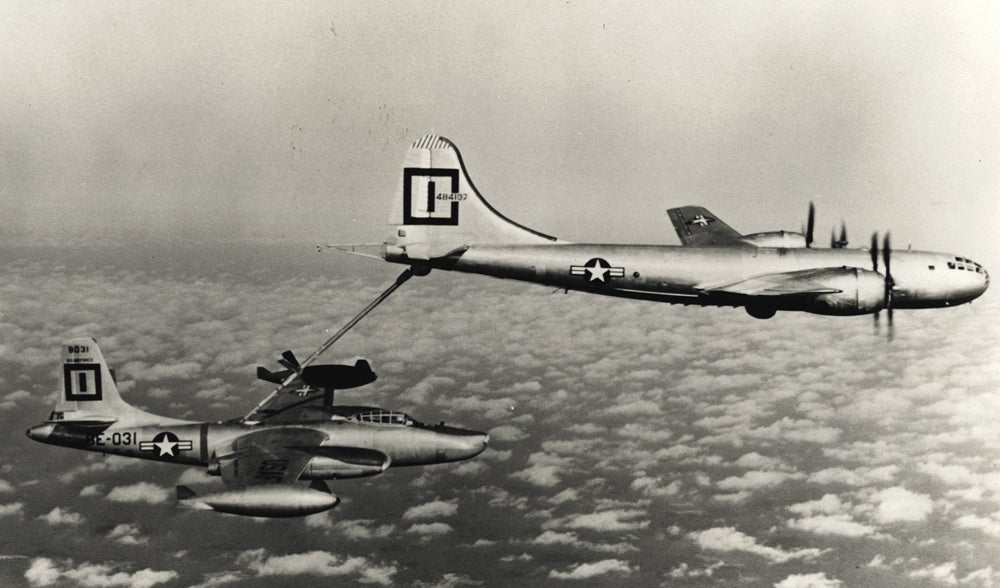
An RB-45 Tornado is refueled by a KB-29 tanker. (US Air Force)
July 29, 1952 – A US Air Force North American RB-45 Tornado completes the first non-stop jet-powered flight across the Pacific Ocean. The !!!error: Indecipherable SUB-paragraph formatting!!! has the distinction of being the first jet-powered bomber to enter US Air Force service, and though it was quickly superseded by the !!!error: Indecipherable SUB-paragraph formatting!!! , the RB-45 reconnaissance variant served until 1959 and made flights over the Soviet Union. To demonstrate the capability of the bomber, a B-45 of the 91st Reconnaissance Wing commanded by Maj. Lou Carrington departed from Alaska and arrived in Japan 9 hours and 50 minutes later, refueling twice in the air along the way. The midair refueling by Air Force !!!error: Indecipherable SUB-paragraph formatting!!! tankers also marked the first time a multiengine jet bomber was refueled in flight. Carrington and his crew were awarded the MacKay Trophy by the Air Force in recognition of the “most meritorious flight of the year.”
!!! UNKNOWN CONTENT TYPE !!!
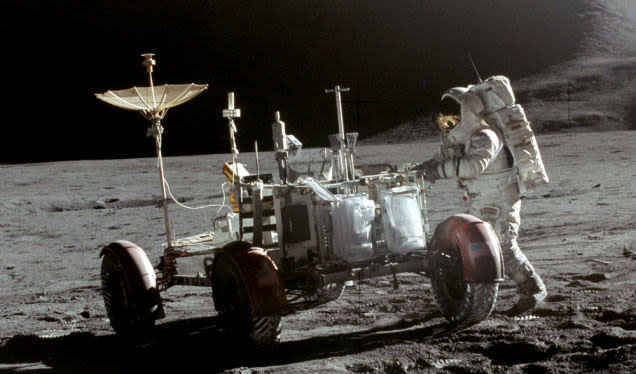
(NASA)
July 30, 1971 – The Apollo 15 mission deploys the first Lunar Rover on the Moon. !!!error: Indecipherable SUB-paragraph formatting!!! was the ninth manned mission launched by NASA as part of the !!!error: Indecipherable SUB-paragraph formatting!!! , and the fourth to land on the Moon. It was also the first of the so-called !!!error: Indecipherable SUB-paragraph formatting!!! which featured extended stays of more than three days on the Lunar surface, with greater emphasis on scientific exploration. In order to cover more ground than was possible on foot, Apollo 15 deployed the first !!!error: Indecipherable SUB-paragraph formatting!!! (LRV), a battery-powered rover that could carry two astronauts at speeds of six to eight mph. Over the course of their stay on the Moon, astronauts !!!error: Indecipherable SUB-paragraph formatting!!! and !!!error: Indecipherable SUB-paragraph formatting!!! covered a total distance of 17.25 miles in the Rover. The Rover, along with ones placed by !!!error: Indecipherable SUB-paragraph formatting!!! and !!!error: Indecipherable SUB-paragraph formatting!!! , remain on the Moon.
!!! UNKNOWN CONTENT TYPE !!!
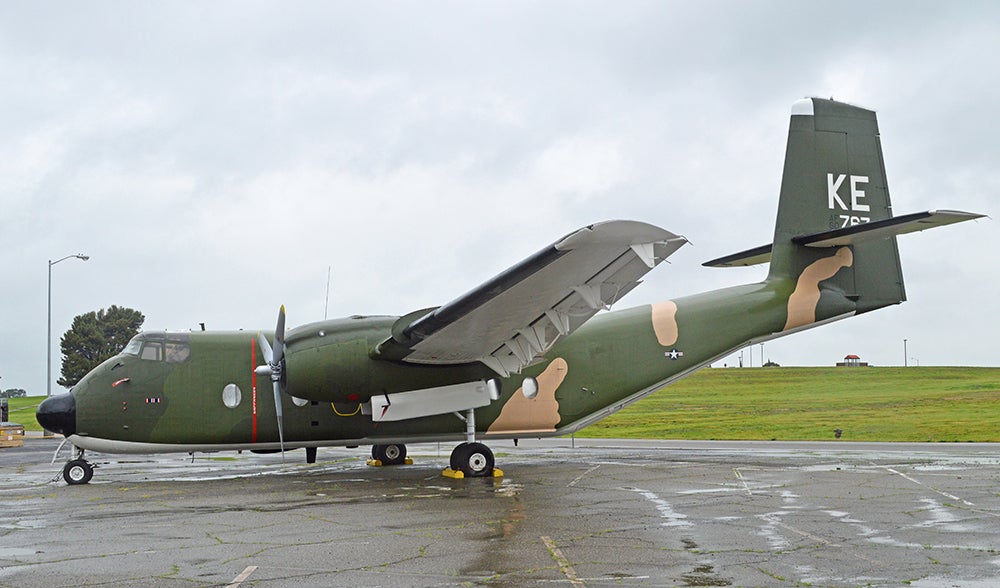
(US Air Force)
July 30, 1958 – The first flight of the de Havilland Canada DHC-4 Caribou,
a cargo aircraft designed for
!!!error: Indecipherable SUB-paragraph formatting!!!
(STOL) to fulfill a requirement from the US Army for a tactical airlifter to supply frontline troops. Following the
!!!error: Indecipherable SUB-paragraph formatting!!!
and
!!!error: Indecipherable SUB-paragraph formatting!!!
, the Caribou was the first aircraft designed by
!!!error: Indecipherable SUB-paragraph formatting!!!
to have two engines, and it entered US Army service in 1961 where it was known as the C-7. Initially seeing service in Vietnam, the Caribou’s ability to operate from runways as short as 1,200 feet made it an ideal complement to the Air Force’s larger cargo airplanes. A total of 307 were produced, and the final Caribous were retired from military service by the Royal Australian Air Force in 2009.
!!! UNKNOWN CONTENT TYPE !!!
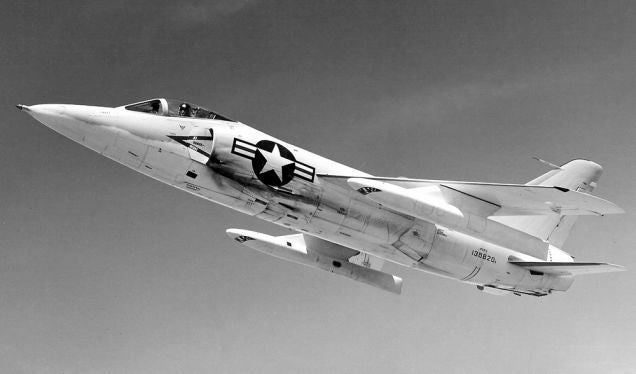
(US Navy)
July 30, 1954 – The first flight of the Grumman F-11 Tiger,
a day fighter developed by Grumman for the US Navy that began as an advanced development of the
!!!error: Indecipherable SUB-paragraph formatting!!!
. Grumman eliminated the wing root air intakes and moved them forward to help reduce drag, made the wing thinner, moved the elevator down to the fuselage, and reshaped the fuselage to take advantage of the newly discovered
!!!error: Indecipherable SUB-paragraph formatting!!!
principle. The Tiger remained a work in progress throughout its career, and also earned the dubious distinction of being the first jet to shoot itself down when it overtook its own bullets in a dive during weapons testing. The Tiger’s operational career was relatively short, though it gained notoriety when the fighter was selected by the Navy’s
!!!error: Indecipherable SUB-paragraph formatting!!!
in 1957. A total of 200 Tigers were produced from 1954-1959, and it was retired from active service in 1961, though it served the Blue Angels until 1969.
!!! UNKNOWN CONTENT TYPE !!!
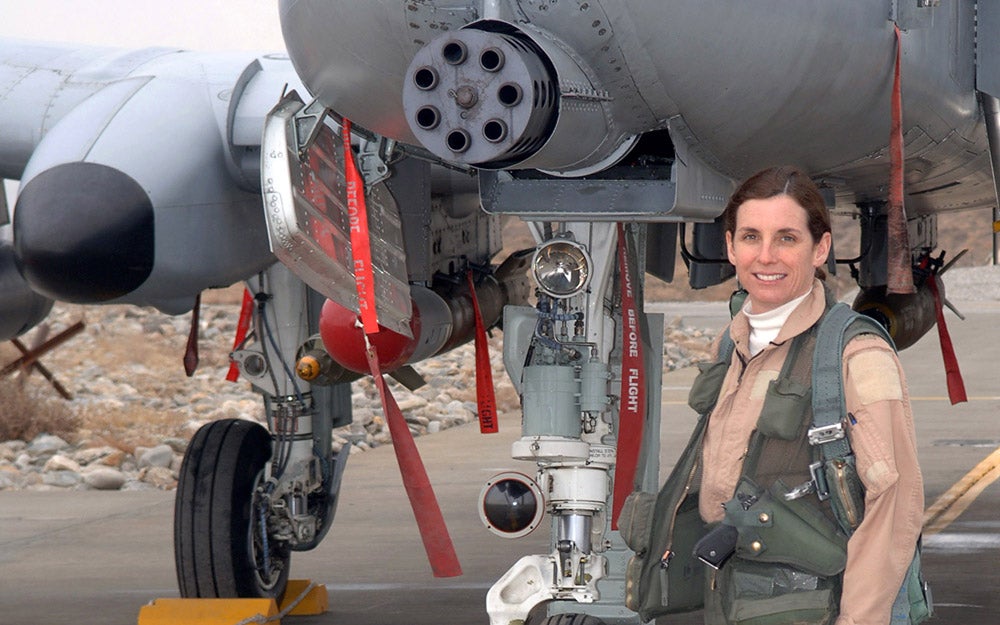
Lt. Col. Martha McSally (US Air Force)
July 31, 1991 – The US Senate votes to allow women to fly combat aircraft.
Women were first allowed to fly US military aircraft in WWII as members of the
!!!error: Indecipherable SUB-paragraph formatting!!!
(WASP), but they were limited to ferrying flights and were considered civilian pilots, receiving no military benefits. The first women military pilots received their wings in 1974 with the US Navy, and then in 1976 with the US Air Force, but they were still excluded from combat missions, even though they were flying cargo and liaison aircraft into war zones such as Panama, Grenada, and the Persian Gulf. Following the
!!!error: Indecipherable SUB-paragraph formatting!!!
,
!!!error: Indecipherable SUB-paragraph formatting!!!
became the first American woman to fly a combat mission when she piloted a
!!!error: Indecipherable SUB-paragraph formatting!!!
in support of
!!!error: Indecipherable SUB-paragraph formatting!!!
over Iraq in 1995.
!!! UNKNOWN CONTENT TYPE !!!
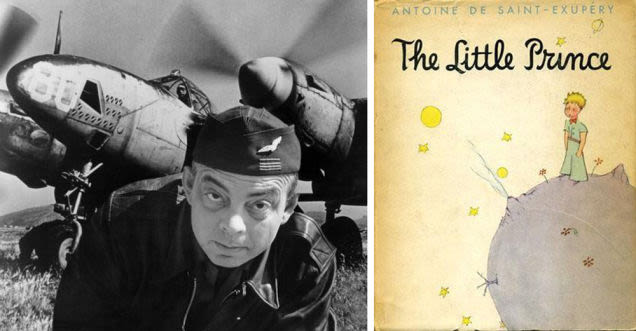
(Author unknown)
July 31, 1944 – The disappearance of Antoine de Saint-Exupéry. Born on June 29, 1900, !!!error: Indecipherable SUB-paragraph formatting!!! was a French author and pilot who is best known for his book !!!error: Indecipherable SUB-paragraph formatting!!! ( The Little Princ e). Exupéry flew for the French Air Force in the early part WWII and, following the fall of France, he traveled to America to encourage the US to join the war. He then joined the !!!error: Indecipherable SUB-paragraph formatting!!! in North Africa, even though his health was failing and he was beyond the age limit for service. While flying a Lockheed F-5B, the unarmed reconnaissance variant of the !!!error: Indecipherable SUB-paragraph formatting!!! , Saint-Exupéry disappeared over the Mediterranean Sea. While remains of a pilot were found, they were not confirmed to be his and the story of his disappearance was never learned.
!!! UNKNOWN CONTENT TYPE !!!
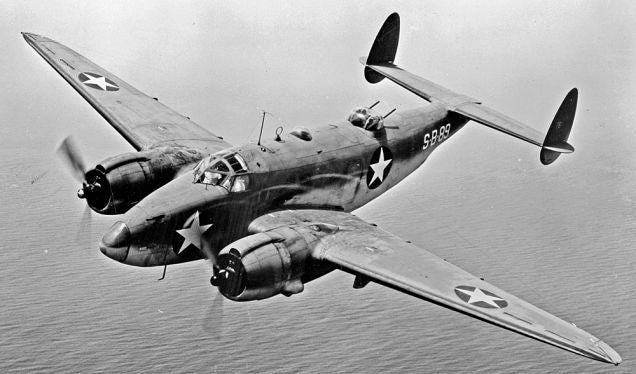
(US Library of Congress)
July 31, 1941 – The first flight of the Lockheed Ventura, a medium bomber and maritime patrol aircraft developed from the !!!error: Indecipherable SUB-paragraph formatting!!! and designed to replace the !!!error: Indecipherable SUB-paragraph formatting!!! . The Ventura was initially flown by the RAF as a medium bomber, but it suffered high combat losses and was pulled from service in favor of the !!!error: Indecipherable SUB-paragraph formatting!!! . Remaining Venturas were moved to maritime patrol missions. In US Army Air Corps service, it was known as the B-34 Lexington and was used primarily for training, though Army Venturas were subsequently transferred to the US Navy where they gained the designation PV-1 and served primarily in the !!!error: Indecipherable SUB-paragraph formatting!!! of Alaska.
!!! UNKNOWN CONTENT TYPE !!!
Connecting Flights
!!! UNKNOWN CONTENT TYPE !!!
!!! UNKNOWN CONTENT TYPE !!!
!!! UNKNOWN CONTENT TYPE !!!
!!! UNKNOWN CONTENT TYPE !!!
!!! UNKNOWN CONTENT TYPE !!!
If you enjoy these Aviation History posts, please let me know in the comments. And if you missed any of the past articles, you can find them all at
!!!error: Indecipherable SUB-paragraph formatting!!!
. You can also find more stories about aviation, aviators and airplane oddities at
!!!error: Indecipherable SUB-paragraph formatting!!!
.
!!! UNKNOWN CONTENT TYPE !!!
 RamblinRover Luxury-Yacht
> ttyymmnn
RamblinRover Luxury-Yacht
> ttyymmnn
07/31/2018 at 12:48 |
|
Interestingly, advances in engine and aerodynamic
tech had the AD Skyraider carrying that same 8,000lb of munition at a greater rate of speed, on a single engine and with only one crewman, by the end of the 40s - and from carriers, at that
. A plane that was so good it remained active in combat into the ‘70s.
 Just Jeepin'
> ttyymmnn
Just Jeepin'
> ttyymmnn
07/31/2018 at 12:57 |
|
I really appreciate the work you put into this, thanks.
The Forrestal incident is quite sobering. My nephew just left the Marines, where his primary role was refueling. Such a dangerous job, even in peacetime.
 ttyymmnn
> RamblinRover Luxury-Yacht
ttyymmnn
> RamblinRover Luxury-Yacht
07/31/2018 at 12:57 |
|
That is a truly remarkable statistic. And now compare that to the F-15X that the USAF is considering acquiring. From our old buddy Tyler at The Warzone :
With the help of the company’s new AMBER missile carrying racks, the F-15X will be able to carry a whopping 22 air-to-air missiles during a single sortie. Alternatively, it could fly with eight air-to-air missiles and 28 Small Diameter Bombs (SDBs), or up to seven 2,000lb bombs and eight air-to-air missiles. We are talking crazy weapons hauling capabilities here. Keep in mind that the F-15C/D Eagle can carry eight air-to-air missiles currently, and the penultimate Eagle variant that is currently being built, the F-15SA, can carry a dozen.
 facw
> RamblinRover Luxury-Yacht
facw
> RamblinRover Luxury-Yacht
07/31/2018 at 12:59 |
|
Yep, and today the single-engine, single-crew member F-35 has a payload of 18,000 lbs.
Granted its quite unlikely there will ever be 3,000 F-35s, as compared to the nearly 13,000 B-17s, there is something to be said for quantity.
 ttyymmnn
> Just Jeepin'
ttyymmnn
> Just Jeepin'
07/31/2018 at 13:00 |
|
Thank you for the kind words. I assure you, it is a labor of love. Thanks for reading.
The Forrestal incident is indeed sobering. It was only through exhaustive fire training that the crew was able to save the ship. I grew up in Norfolk back in the 80s, and I remember the huge plumes of oil smoke you could see when the Sailors were training to fight fires. Battling flames in those enclosed spaces would be terrifying, but the alternative is more so.
 RamblinRover Luxury-Yacht
> facw
RamblinRover Luxury-Yacht
> facw
07/31/2018 at 13:06 |
|
True - but 2.25 times the munitions at 2.4 times the max takeoff weight - nearly as heavy as the B17. The Able Dog was less than half the max takeoff weight of a Flying Fortress. It arguably speaks most to just how big
we build
engines
these days.
 ttyymmnn
> RamblinRover Luxury-Yacht
ttyymmnn
> RamblinRover Luxury-Yacht
07/31/2018 at 13:51 |
|
You could still fly the A-1 with great effectiveness today over places like Syria and Afghanistan. The AF is spending tons of money to develop a turbojet powered ground attack aircraft, when it would be cheaper to build Spads!
 facw
> ttyymmnn
facw
> ttyymmnn
07/31/2018 at 13:52 |
|
Of course one of the things that made the Forrestal fire worse was that they lost so many people skilled in firefighting and damage control early on when the bombs cooked off. I’m sure it led the Navy to require even more demanding training, along with the new improved fire suppression equipment requirements.
 thejustache
> ttyymmnn
thejustache
> ttyymmnn
07/31/2018 at 13:58 |
|
There is a large number (flock?) of DHC-4 Caribou in various states down at the Cape May airport in New Jersey . I believe there is a company there that does turboprop conversions on them and collects every airframe they can for parts. I stopped at the NAS Wildwood aviation museum while I was down that way for vacation earlier this year and took a number of photos, but they’re on a film camera so I need to develop them still
 ttyymmnn
> thejustache
ttyymmnn
> thejustache
07/31/2018 at 14:10 |
|
I’d love to see those photos. I toured a Caribou at an airshow that still had bullet holes in it from Vietnam.
 RamblinRover Luxury-Yacht
> ttyymmnn
RamblinRover Luxury-Yacht
> ttyymmnn
07/31/2018 at 14:24 |
|
ADs were lost in significant numbers to enemy AA and SAM over Vietnam, but our air defense suppression is arguably a bit better since then. More man-portable systems are out there, but if you’re not flying at altitude, the target window is slight; many are IR-guided, the AD makes for a very muted IR target and modern radar jamming can fry a small receiver quite well. I like those odds.
One thing necessary is
the hand in glove overwatch sort of CAP system that the Marines and Navy practiced in Korea, and which made the withdrawal from Chosin possible. Enemy columns were regularly picked off while closing to short engagement range, roadblocks and ambushes were rocketed, enemy harassment helos and scout patrols were dealt with within rifle range, because Navy observers were always in contact (either in planes or with radios) and fresh planes were always entering the control area. The Army and Air Force never used to be able to pull that off due to difference in control doctrine
, and while modern battle net tech makes it more convenient, I don’t know if they’ve yet got a handle on things to that extent. Simplest is best, and helps prevent friendly fire - while being capable of just-in-time help where it’s needed.
 thejustache
> ttyymmnn
thejustache
> ttyymmnn
07/31/2018 at 14:34 |
|
That would be really cool to see. The DeHavilland Beaver is one of my all time favorite planes, but I have to admit I had to look up what the Caribou was when I first saw them
 Hamtractor
> ttyymmnn
Hamtractor
> ttyymmnn
07/31/2018 at 16:20 |
|
It is my personal opinion, which is extremely imp ortant and respected throughout the four corners of the world that the F-5/F-20 series of fighters is the se xiest 3rd/4th generation fighter ever produced, and that it is a shame it lost ou t due to politics and bureaucracy...
 ttyymmnn
> Hamtractor
ttyymmnn
> Hamtractor
07/31/2018 at 16:58 |
|
I would have to agree with you on that score. If they hadn’t removed the export ban on the F-16, it might have had a chance. But exporting Falcons to the rest of the world meant that the Air Force’s Falcons got cheaper. It also didn’t help that the F-16 was being built in Ft. Worth, hometown of then-Speaker of The House J im Wright.
 RacinBob
> ttyymmnn
RacinBob
> ttyymmnn
07/31/2018 at 19:20 |
|
Nice work, I always enjoy these.
 ttyymmnn
> RacinBob
ttyymmnn
> RacinBob
07/31/2018 at 19:20 |
|
Thank you!
 facw
> ttyymmnn
facw
> ttyymmnn
07/31/2018 at 22:10 |
|
I was under the impression that they were looking at the A-29 and AT-6 to slot in below the A-10 in places where fast jets aren’t required. The jet-powered Textron Scorpion was also competing for that role, but it looks like they were eliminated.
 facw
> thejustache
facw
> thejustache
07/31/2018 at 22:15 |
|
Hmm, I guess that’s what this is (also F-14!) :
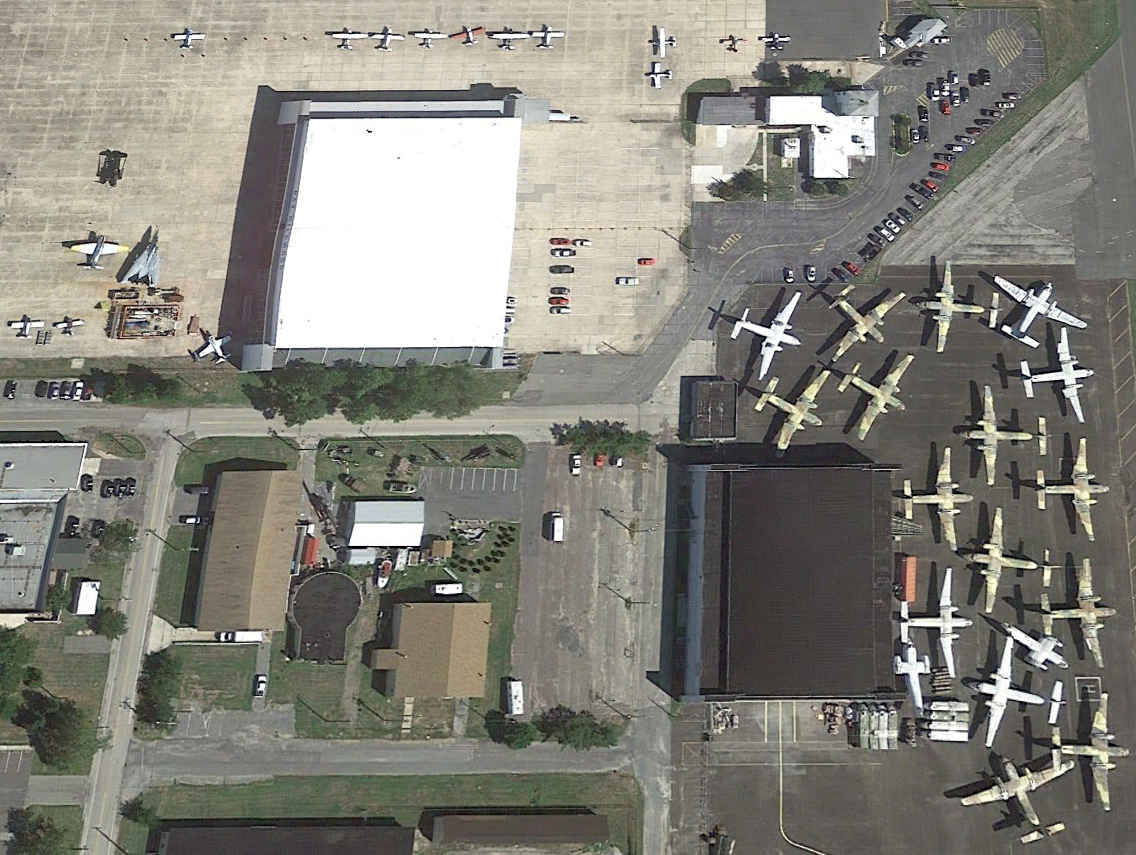
Yeah, that’s a lot of them! I feel especially bad for those stacks of fuselages down at the bottom.
 ttyymmnn
> facw
ttyymmnn
> facw
07/31/2018 at 22:25 |
|
They are, but I don’t know where they are in that process right now. Here’s a fairly recent update.
 thejustache
> facw
thejustache
> facw
08/01/2018 at 09:30 |
|
That’s the place. The NAS Wildwood museum is pretty neat (that’s where the f-14 is from, as well as an f-16, f-5, a mig of some variety, and a number of prop planes, helicopters, and a surprising number of radial and jet engines on stands ). As it was a training base in WW2 there is an emphesis on that history, with the centerpiece being a TBM Avenger that was built in NJ and served there as a torpedo bombing trainer. I took a lot of photos but I only have 2 on my computer. S eeing all the Caribou was just icing on the cake!
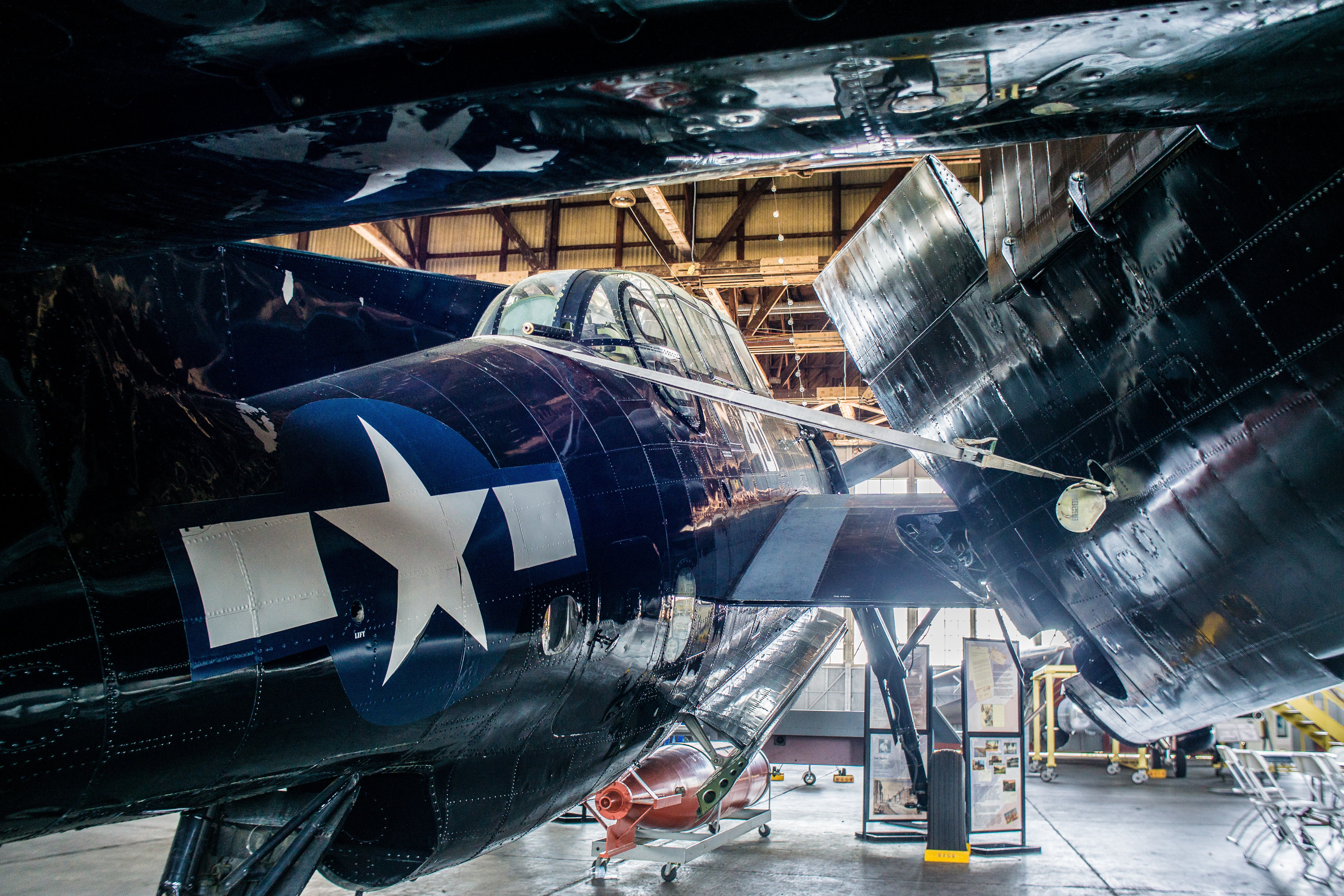
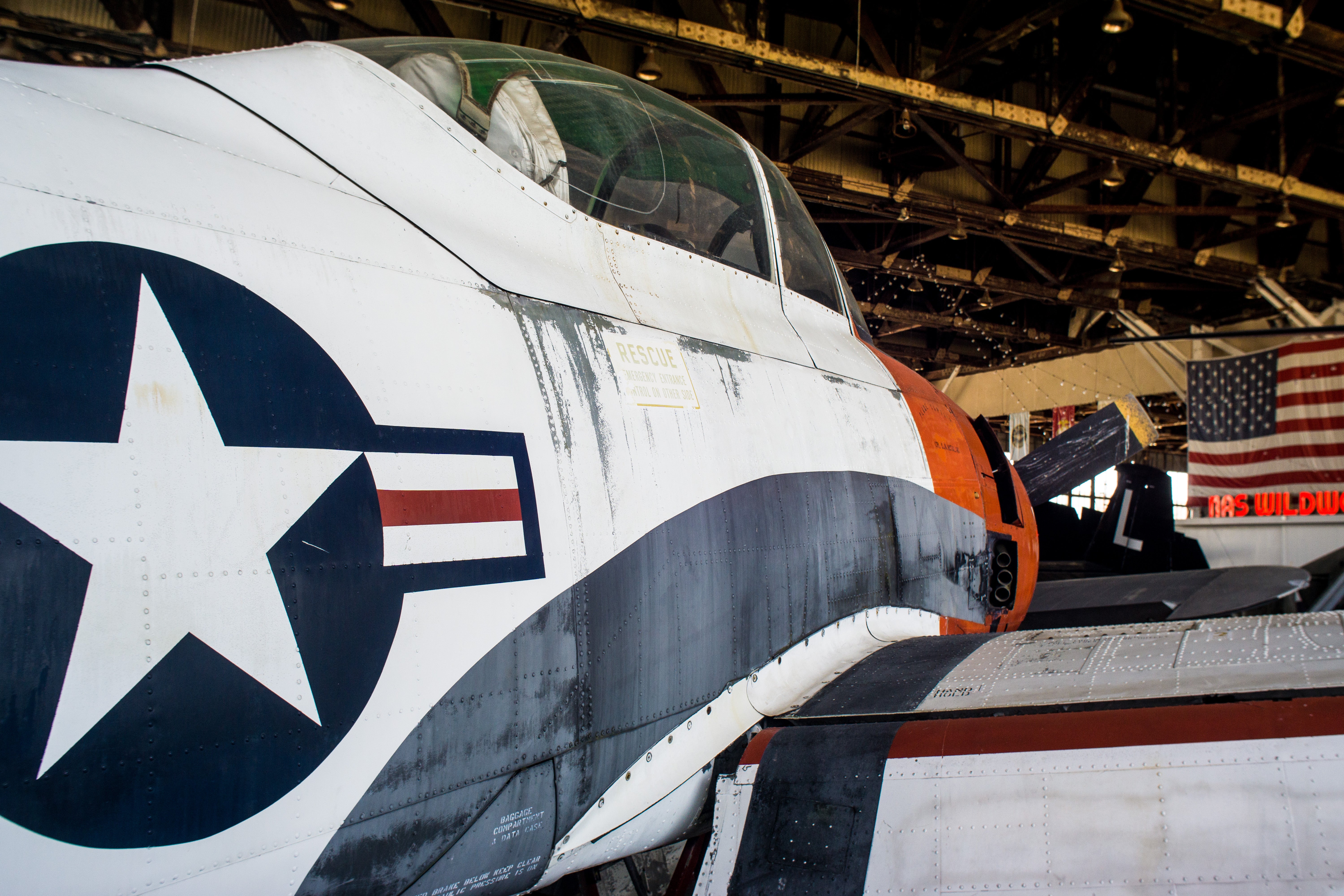
 Hamtractor
> ttyymmnn
Hamtractor
> ttyymmnn
08/01/2018 at 11:41 |
|
I was a DC in the Navy in the early 90's, and we watched hours and hours of footage from the Forrestal incident during school. Even in bootcamp, non-firefighting personnel watched that footage to hammer home the idea that EVERY sailor on a ship is expected to be able to fight fires and do damage control. Over half of the Forrestal’s designated firefighting crew was killed or injured in the first few minutes of that terrible day, and most of the actual firefighting efforts were eventually handled by regular sailors, not Damage Controlmen...